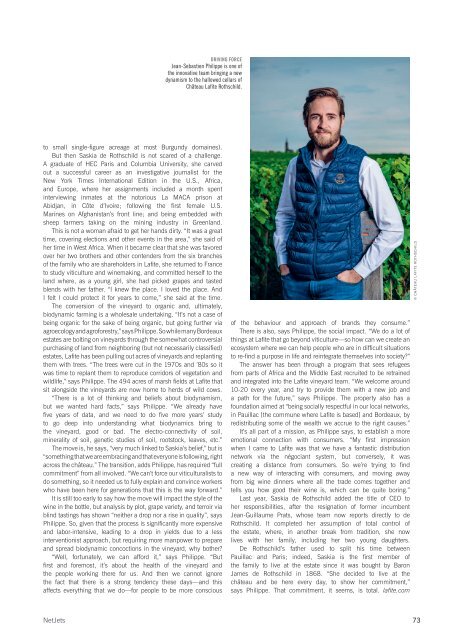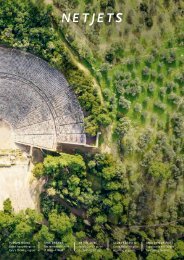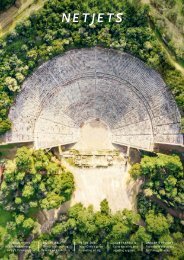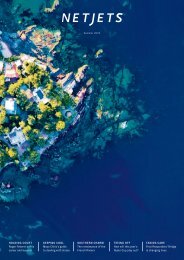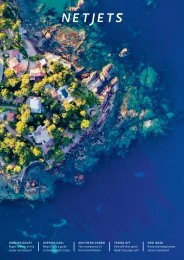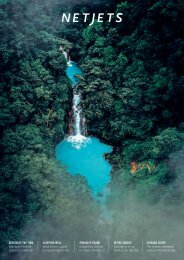Create successful ePaper yourself
Turn your PDF publications into a flip-book with our unique Google optimized e-Paper software.
DRIVING FORCE<br />
Jean-Sebastien Philippe is one of<br />
the innovative team bringing a new<br />
dynamism to the hallowed cellars of<br />
Château Lafite Rothschild.<br />
to small single-figure acreage at most Burgundy domaines).<br />
But then Saskia de Rothschild is not scared of a challenge.<br />
A graduate of HEC Paris and Columbia University, she carved<br />
out a successful career as an investigative journalist for the<br />
New York Times International Edition in the U.S., Africa,<br />
and Europe, where her assignments included a month spent<br />
interviewing inmates at the notorious La MACA prison at<br />
Abidjan, in Côte d’Ivoire; following the first female U.S.<br />
Marines on Afghanistan’s front line; and being embedded with<br />
sheep farmers taking on the mining industry in Greenland.<br />
This is not a woman afraid to get her hands dirty. “It was a great<br />
time, covering elections and other events in the area,” she said of<br />
her time in West Africa. When it became clear that she was favored<br />
over her two brothers and other contenders from the six branches<br />
of the family who are shareholders in Lafite, she returned to France<br />
to study viticulture and winemaking, and committed herself to the<br />
land where, as a young girl, she had picked grapes and tasted<br />
blends with her father. “I knew the place. I loved the place. And<br />
I felt I could protect it for years to come,” she said at the time.<br />
The conversion of the vineyard to organic and, ultimately,<br />
biodynamic farming is a wholesale undertaking. “It’s not a case of<br />
being organic for the sake of being organic, but going further via<br />
agroecology and agroforestry,” says Philippe. So while many Bordeaux<br />
estates are bolting on vineyards through the somewhat controversial<br />
purchasing of land from neighboring (but not necessarily classified)<br />
estates, Lafite has been pulling out acres of vineyards and replanting<br />
them with trees. “The trees were cut in the 1970s and ’80s so it<br />
was time to replant them to reproduce corridors of vegetation and<br />
wildlife,” says Philippe. The 494 acres of marsh fields at Lafite that<br />
sit alongside the vineyards are now home to herds of wild cows.<br />
“There is a lot of thinking and beliefs about biodynamism,<br />
but we wanted hard facts,” says Philippe. “We already have<br />
five years of data, and we need to do five more years’ study<br />
to go deep into understanding what biodynamics bring to<br />
the vineyard, good or bad. The electro-connectivity of soil,<br />
minerality of soil, genetic studies of soil, rootstock, leaves, etc.”<br />
The move is, he says, “very much linked to Saskia’s belief,” but is<br />
“something that we are embracing and that everyone is following, right<br />
across the château.” The transition, adds Philippe, has required “full<br />
commitment” from all involved. “We can’t force our viticulturalists to<br />
do something, so it needed us to fully explain and convince workers<br />
who have been here for generations that this is the way forward.”<br />
It is still too early to say how the move will impact the style of the<br />
wine in the bottle, but analysis by plot, grape variety, and terroir via<br />
blind tastings has shown “neither a drop nor a rise in quality”, says<br />
Philippe. So, given that the process is significantly more expensive<br />
and labor-intensive, leading to a drop in yields due to a less<br />
interventionist approach, but requiring more manpower to prepare<br />
and spread biodynamic concoctions in the vineyard, why bother?<br />
“Well, fortunately, we can afford it,” says Philippe. “But<br />
first and foremost, it’s about the health of the vineyard and<br />
the people working there for us. And then we cannot ignore<br />
the fact that there is a strong tendency these days—and this<br />
affects everything that we do—for people to be more conscious<br />
of the behaviour and approach of brands they consume.”<br />
There is also, says Philippe, the social impact. “We do a lot of<br />
things at Lafite that go beyond viticulture—so how can we create an<br />
ecosystem where we can help people who are in difficult situations<br />
to re-find a purpose in life and reintegrate themselves into society?”<br />
The answer has been through a program that sees refugees<br />
from parts of Africa and the Middle East recruited to be retrained<br />
and integrated into the Lafite vineyard team. “We welcome around<br />
10-20 every year, and try to provide them with a new job and<br />
a path for the future,” says Philippe. The property also has a<br />
foundation aimed at “being socially respectful in our local networks,<br />
in Pauillac [the commune where Lafite is based] and Bordeaux, by<br />
redistributing some of the wealth we accrue to the right causes.”<br />
It’s all part of a mission, as Philippe says, to establish a more<br />
emotional connection with consumers. “My first impression<br />
when I came to Lafite was that we have a fantastic distribution<br />
network via the négociant system, but conversely, it was<br />
creating a distance from consumers. So we’re trying to find<br />
a new way of interacting with consumers, and moving away<br />
from big wine dinners where all the trade comes together and<br />
tells you how good their wine is, which can be quite boring.”<br />
Last year, Saskia de Rothschild added the title of CEO to<br />
her responsibilities, after the resignation of former incumbent<br />
Jean-Guillaume Prats, whose team now reports directly to de<br />
Rothschild. It completed her assumption of total control of<br />
the estate, where, in another break from tradition, she now<br />
lives with her family, including her two young daughters.<br />
De Rothschild’s father used to split his time between<br />
Pauillac and Paris; indeed, Saskia is the first member of<br />
the family to live at the estate since it was bought by Baron<br />
James de Rothschild in 1868. “She decided to live at the<br />
château and be here every day, to show her commitment,”<br />
says Philippe. That commitment, it seems, is total. lafite.com<br />
© CHÂTEAU LAFITE ROTHSCHILD<br />
NetJets<br />
73


